Bodies Study guides, Class notes & Summaries
Looking for the best study guides, study notes and summaries about Bodies? On this page you'll find 20340 study documents about Bodies.
All 20.340 results
Sort by
 Popular
Popular
-
CSL2601 Assignment 2 (ANSWERS) Semester 1 2024 - DISTINCTION GUARANTEED
- Exam (elaborations) • 28 pages • 2023
-
- $2.78
- 104x sold
- + learn more
Well-structured CSL2601 Assignment 2 (ANSWERS) Semester 1 2024 - DISTINCTION GUARANTEED. (DETAILED ANSWERS - DISTINCTION GUARANTEED!). ...... 1. The most significant aspect of the case of Economic Freedom Fighters v Speaker of the National Assembly 2018 (2) SA 571 (CC) (EFF II) is that the judiciary has too much political power and intrudes into the executive domain. 2. As a member of the uMkhonto we Sizwe party, former President Jacob Zuma has announced his intention to campaign against the r...
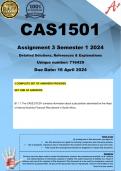
-
CAS1501 Assignment 3 (COMPLETE ANSWERS) Semester 1 2024 (716429) - DUE 16 April 2024
- Exam (elaborations) • 18 pages • 2024 Popular
-
- $2.78
- 93x sold
- + learn more
CAS1501 Assignment 3 (COMPLETE ANSWERS) Semester 1 2024 (716429) - DUE 16 April 2024 ;100% TRUSTED workings, explanations and solutions. for assistance Whats-App.......0.6.7..1.7.1..1.7.3.9......... Read the following CASE STUDY: CASE STUDY Position advertised: Head: Internal Audit Recruiter: Financial Recruitment Job Ref: JHB00521/EG Date posted: Thursday, 14 March 2024 Location: SANDTON, South Africa Salary: R3600000 Annually SUMMARY: An esteemed company in the financial sector with...
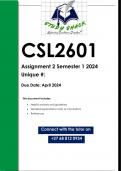
-
CSL2601 Assignment 2 (QUALITY ANSWERS) Semester 1 2024
- Exam (elaborations) • 35 pages • 2024
-
- $2.78
- 54x sold
- + learn more
This document contains workings, explanations and solutions to the CSL2601 Assignment 2 (QUALITY ANSWERS) Semester 1 2024. For assistance call or us on 0.6.8..8.1.2..0.9.3.4.....1. The most significant aspect of the case of Economic Freedom Fighters v Speaker of the National Assembly 2018 (2) SA 571 (CC) (EFF II) is that the judiciary has too much political power and intrudes into the executive domain. 2. As a member of the uMkhonto we Sizwe party, former President Jacob Zuma has announced his ...
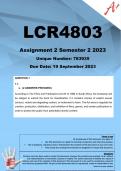
-
LCR4803 Assignment 2 (COMPLETE ANSWERS) Semester 2 2023 (783935) - DUE 19 September 2023
- Exam (elaborations) • 21 pages • 2023
-
- $2.78
- 45x sold
- + learn more
LCR4803 Assignment 2 (COMPLETE ANSWERS) Semester 2 2023 () - DUE 19 September 2023 100% TRUSTED workings, explanations and solutions. Whatsapp 067 171 1739 for assistance ................................................................... QUESTION 1 1.1X invites Y to watch a film at his house. The film is the long•awaited sequel to an earlier blockbuster film and not yet available in South Africa. However, the book on which the movie is based, is available in bookshops. It transpires that t...
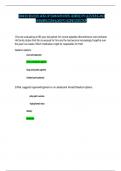
-
BRAND NEW 2023 APEA 3P EXAM WITH 100% VERIFIED 75 QUESTIONS AND ANSWERS DOWNLOAD TO SCORE DISTICTION
- Exam (elaborations) • 42 pages • 2023
-
Available in package deal
-
- $36.49
- 26x sold
- + learn more
BRAND NEW 2023 APEA 3P EXAM WITH 100% VERIFIED 75 QUESTIONS AND ANSWERS DOWNLOAD TO SCORE DISTICTION 1.You are evaluating an 80 year old patient for recent episodes of incontinence and confusion. His family states that this is unusual for him and he has become increasingly forgetful over the past two weeks. Which medication might be responsible for this? Question options oral corticosteroid short acting beta agonist long acting beta agonist inhaled corticosteroid 2.What suggests...
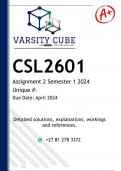
-
CSL2601 Assignment 2 (DETAILED ANSWERS) Semester 1 2024 - DISTINCTION GUARANTEED
- Exam (elaborations) • 32 pages • 2024
-
- $2.78
- 15x sold
- + learn more
CSL2601 Assignment 2 (ANSWERS) Semester 1 2024 - DISTINCTION GUARANTEED. Answers, guidelines, workings and references..... ....... 1. The most significant aspect of the case of Economic Freedom Fighters v Speaker of the National Assembly 2018 (2) SA 571 (CC) (EFF II) is that the judiciary has too much political power and intrudes into the executive domain. 2. As a member of the uMkhonto we Sizwe party, former President Jacob Zuma has announced his intention to campaign against the right of LGBT...
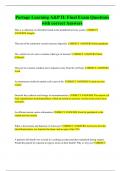
-
Portage Learning A&P II: Final Exam Questions with correct Answers
- Exam (elaborations) • 21 pages • 2023
- Available in package deal
-
- $15.49
- 12x sold
- + learn more
Portage Learning A&P II: Final Exam Questions with correct Answers This is a collection of cell bodies found in the peripheral nervous system. This part of the autonomic system increases digestion. The ventral root of a nerve contains what type of neurons? This part of a neuron conducts nerve impulses away from the cell body. An interneuron inside the spinal cord is part of the: Describe the synthesis and storage of neurotransmitters. An afferent neuron carries information: What i...

-
DAANCE Exam Study Questions | 130 Questions with 100% Correct Answers | Updated 2023 | Guaranteed A+
- Exam (elaborations) • 16 pages • 2023
- Available in package deal
-
- $12.49
- 31x sold
- + learn more
The "T" wave on an ECG tracing is evidence of what change in polarization? - Repolarization of the ventricles What anatomical structure located at the top of the larynx closes the airway and prevents foreign bodies from entering the trachea? - The epiglottis Which structure is most likely to cause obstruction of the airway when an anesthetized patient is lying in a supine position? - The tongue What is the "supine" position? - Pt laying face up What is the "fowlers" position? - Pt i...
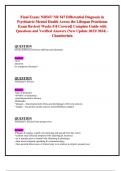
-
Final Exam: NR547/ NR 547 Differential Diagnosis in Psychiatric-Mental Health Across the Lifespan Practicum Exam Review| Weeks 5-8 Covered| Complete Guide with Questions and Verified Answers (New Update 2023/ 2024) - Chamberlain
- Exam (elaborations) • 95 pages • 2023
-
Available in package deal
-
- $11.99
- 2x sold
- + learn more
Final Exam: NR547/ NR 547 Differential Diagnosis in Psychiatric-Mental Health Across the Lifespan Practicum Exam Review| Weeks 5-8 Covered| Complete Guide with Questions and Verified Answers (New Update 2023/ 2024) - Chamberlain QUESTION tell the difference between delirium and dementia Answer: onset attention do symptoms fluctuate? QUESTION Alzheimer's disease Answer: -type of dementia • 60-80% of dementias -neurodegenerative disease -Hallmarks: • pla...
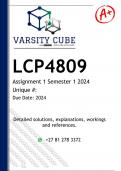
-
LCP4809 Assignment 1 (DETAILED ANSWERS) Semester 1 2024 - DISTINCTION GUARANTEED
- Exam (elaborations) • 9 pages • 2024
-
- $2.78
- 3x sold
- + learn more
LCP4809 Assignment 1 (DETAILED ANSWERS) Semester 1 2024 - DISTINCTION GUARANTEED - DISTINCTION GUARANTEED. Answers, guidelines, workings and references..... ........ ASSIGNMENT 01 Instructions: 1. Please submit this assignment as a pdf document. 2. Reference the reasons for your answers using the OSCOLA method of referencing. 3. The assignment counts 40 marks. Indicate whether the following questions are true or fa...

-
LCR4803 Assignment 2 (ANSWERS) Semester 2 2023 - DISTINCTION GUARANTEED
- Exam (elaborations) • 17 pages • 2023
-
- $2.78
- 8x sold
- + learn more
Well-structured LCR4803 Assignment 2 (ANSWERS) Semester 2 2023 - DISTINCTION GUARANTEED. (DETAILED ANSWERS - DISTINCTION GUARANTEED!). QUESTION 1 1.1X invites Y to watch a film at his house. The film is the long•awaited sequel to an earlier blockbuster film and not yet available in South Africa. However, the book on which the movie is based, is available in bookshops. It transpires that the film contains scenes of explicit sexual conduct which areviolent and degrading, as well as the inflict...

Study stress? For sellers on Stuvia, these are actually golden times. KA-CHING! Earn from your study resources too and start uploading now. Discover all about earning on Stuvia


